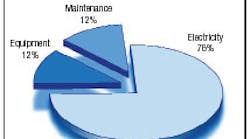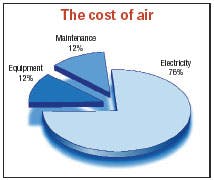Electric motors consume most of the electricity used in manufacturing plants. Compressed air systems consume a significant portion as well. Surprisingly, compressed air is not typically viewed as a cost of production. However, the generation of compressed air requires a huge amount of energy and cost.
According to different estimates provided by the U.S. Department of Energy, the automotive industry, and pneumatic equipment distributors, the cost of air ranges from $0.16 to $0.30 per 1000 ft3. Buying electricity accounts for 76% of the cost. Equipment and maintenance also factor in to the cost of air, Figure 1.
How to save
There are many savings opportunities on both the supply and demand side of the compressed air equation. Different compressor types that supply compressed air systems operate at different efficiencies. Piston, rotary screw, and centrifugal compressors operate between 50-90% efficiency, depending upon the application. When selecting compressor systems, current and future demands on the system must be considered. On the demand side, a combination of best practices and pressure-down solutions can mean significant savings on the plant floor.
A piecemeal approach to machinery designs and oversizing applications worsens the problem through leaks, mismatched supply and demand for air, and inappropriate uses of compressed air systems. It results in energy-wastes, increased operating costs, and reduced productivity. Manufacturing facilities are slowly beginning to implement efficiency improvements that lower costs.
Automobile manufacturers are very proactive in this area, but manufactures in other industries lag far behind. Detroit Edison reports that less than 20% of its customers take advantage of a free facility audit to identify ways to reduce energy use. Only about 10% of the compressed air systems in operation are regularly audited and improved.
To step up awareness, the Department of Energy supports organizations such as the Compressed Air Challenge, a non-profit whose mission is to develop and provide resources that educate industry about opportunities to increase profits through compressed air system optimization.
Efficient use of compressed air can be realized through better pneumatic designs and component/system selection, as well as aggressive best practice initiatives and maintenance programs that fix and prevent leaks in pneumatic systems.
Design considerations
Proper sizing of system components, such as tubing, hose, connectors, and fittings optimizes system efficiency and minimizes component cost.
Oversizing valves wastes energy and takes up valuable space in machine and system designs. There are many formulas available from air system specialists that can be used to specify the proper CV for valves.
Using valves with solenoid air pilot and low watt coil designs also can reduce electrical costs. Burnouts are reduced; common coils in various valve sizes lower costs for replacements and labor time; and shifting speeds are faster for higher efficiencies.
Fittings are another source of drain on air systems. Using straight fittings, rather than 45° or 90° elbow fittings, wherever possible, minimizes pressure drop. Properly applying thread sealant helps prevent leakage and system contamination.
When considering actuators, select higher quality, repairable models that last longer, leak less, and reduce maintenance costs. Typically, cylinders can be sized at 60 psig to provide a safety margin. Using regulators to pressure down can reduce air costs. Installing reoften verse flow regulators, piped between the valve and the cylinder, provides independent pressure control for extend and retract. The non-relieving design of these regulators saves air, as well as wear, on components and mechanical devices.
Plants without proactive maintenance programs or resources should implement smart air prep systems that ensure adequate airflow by servicing filtration and pressure controls. These systems include drip leg assemblies to protect equipment against water and contamination, primary and coalescing filters, and pressure drop indicators and sensors, used to complement and support maintenance programs. Visual and electrical sensors detect pressure drops as filters clog. Clogged filters reduce flow, increasing both air and maintenance costs.
Evaluate and identify
Audits of compressed air systems often focus on two main objectives:
- specifying correct air pressure levels by analyzing and reviewing the application of compressors, headers, and dryers to make air savings recommendations.
- reviewing compressed air systems for leaks and incorporating leak prevention programs into regular plant operations.
High-pressure air should not be specified or used unless it is absolutely necessary. Reducing required operating pressure provides a huge savings in air costs and maintenance. In addition, specifying and using correct pressure levels for equipment improves the performance of most compressed air systems.
Let's consider cylinders. Typically, cylinders work in one direction and are usually operated at a pressure well above what's required. This high-pressure operation tears up equipment prematurely and wears on the actuators as well. In the retract direction, the cylinder probably has very little load and can be retracted at half of the typical operating pressure. Instead of running actuators at 80 psig extend and retract, operate them at 60 psig extend and 40 psig retract and they will still effectively perform the work required. The resulting air savings can translate into several thousand dollars per actuator per year.
If a system isn't regulated and monitored properly, artificial demand for air is created. Air pressure in excess of what is needed for an application's requirements increases energy demand and costs.
As illustrated in the cylinder example above, lowering pressure to operational efficiencies saves energy and money. To reiterate, if a system operates in the 100 psi range, energy consumption can be reduced by 1% for each drop in average system pressure of 2 psi.
Evaluating the pressure relationships among main headers, compressors, and dryers on the air supply side can illustrate where and how adjustments can be made to lower the required compressor discharge pressure. False assumptions about air pressure requirements can result in unnecessary purchases for new equipment. If a system audit confirms that a plant can pressure down, it may be able to avoid the purchase of additional satellite compressors.
Vacuum considerations
Vacuum applications provide another opportunity for pressuring down on air demand. Many vacuum cups that operate satisfactorily on 70 psig, for instance, may be supplied with air at 100 psig, which is completely unnecessary. Some manufacturers offer air economizing/ emergency stop vacuum solutions that enable the vacuum to be turned off over 90% of the time that the part is present.
Additional benefits of air economizing solutions include an emergency stop option for enhanced safety, as well as noise reduction in the workplace.
Stopping those leaks
Leaks can account for as much as 20-30% of a compressor's output. They also contribute to operating problems because of fluctuating system pressure that causes equipment to function less effectively, and decreased equipment service life because of extra cycling and increased run time.
Compressed air can be lost through multiple locations in the system, but the most common problem areas are faulty couplings, joints, quick disconnects, hoses or tubes, fittings, FRLs, and valves. The rate of leakage depends upon the supply pressure in the system and the size of the source of the leak. The amount of lost air is measured in cfm. The box at left provides examples of different leak sizes by rate and their cost per year.
Using an ultrasonic acoustic detector is the most effective way to detect system leaks. These detectors locate the source of high frequency hissing coming from leaks. Once leaks are identified, they need to be tagged and repaired. This is an ongoing effort. Because leaks will continue to occur, a leak prevention program should be incorporated to help maintain the efficiency and cost-effectiveness of the air system.
As leaks are repaired, reevaluation of the compressed air system should follow. Many plants need to work with air system specialists to adjust compressor controls. This often entails reducing compressor run times to match the reduced demand. These system audits and corresponding adjustment can often be achieved with minimal capital expenditures. Saving energy is the immediate payoff, along with lower operating costs, better efficiency, and improved quality.
Randy Pellett is director of automation for Exotic Automation & Supply, a certified Parker distributor. Email him at [email protected]
Compressed air at a glance
|
Demanding control of your systemMost leak costs and repairs are put forth by manufacturers of ultrasonic leak detectors, and go something like this: a 1/4-in. orifice (leak) blowing at 100 psi will pass approximately 104 cfm, which equates to about a 25-hp compressor. Running 25 hp for 8000 hours per year at 0.07kw/hr would cost $10,444. Thus, detecting/fixing leaks can save $10k a year. However, there are a couple of things wrong with this:
The solution to these problems is a close look at how the system is set up, so that a level of pressure control is available. That is, tightly control the demand pressure so that a decrease in leak load will not increase the localized pressure. Likewise, have enough control on the compressor output so that a decrease in demand will be realized with an offsetting reduction in on-line horsepower. Extremely important: All compressed air systems are unique and all components must be understood in their relation to the whole before an effective solution can be identified. A detailed analysis of the system is essential to avoid improper allocation of capital. A good example of this is the local control methodology of the air compressors. Control methodology is how different compressors adjust to partial load. In this example, as you fix leaks, your cfm requirements will decrease. In a modulating machine, this will cause the inlet valve to close off farther, as the compressor doesn't need to make as much air. The problem with modulation control is that it draws a vacuum under the valve, and the result is a relatively higher break horsepower being used. For example, a modulating machine at 70% load will still pull 93% of its full load horsepower. Similarly, a centrifugal-type compressor can only back down so far depending on its surge points before it starts to blow off. (Blow off is a bypass valve that opens sending excess compressed air to atmosphere.) So if it's close to the surge point and you fix leaks — reduce the cfm it needs to make — then instead of lowering its break horsepower, it will simply blow off more air to atmosphere and you have gained nothing. This is why you need a good handle on the air system as a whole and how each part effects it, especially how the system reacts to part loading. Submitted by Robert Horneman, marketing manager, Ingersoll Rand Industrial Technologies. Contact Robert at (704) 655-4392. |
Best pneumatic practices:air leakage rates and cost * While almost no systems would have 3/8-in. leaks, the sum total of all leaks in a system may be equal to this figure. |


